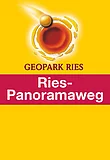The second stage of the Ries Panorama Trail leads from Wemding’s Old Town to the pilgrimage church Maria Brünnlein, which was awarded the rank of basilica in 1998 and is one of the most visited pilgrimage sites in Bavaria. A panorama panel at the top of the Hessenbühl hill explains the magnificent view of the entire rim of the Ries Crater. An outcrop in Central-Franconian Polsingen reveals a reddish, vesicular (with small cavities) rock with crystalline inclusions. It is an impact-melt breccia that was formed during the asteroid impact. On the way towards Megesheim, even more panoramic views of the Ries appear. It is well worth taking a short detour to Hainsfarth′s sports fields to the Ries-lake limestone on the Burschel, where the limestone cliff formed by green algae chronicles the Ries lake that once filled the Crater. In Oettingen, follow hidden walkways to the Schlossstraße to admire half-timbered buildings and historical architecture.
Wemding – A rural Bavarian town shaped by agriculture:
The place name ending in “-ing” is characteristic of the Ries; it indicates the early affiliation with Bavaria. In 1467 the then rural town of Wemding became part of the Duchy of Bavaria. The agrarian influences on the town are still apparent today in several houses. Tanners used to clean the hides at the Häutbachturm—hence the name of the tower, literally translated as “hide-stream tower”—before hanging them on the railings of the town wall to dry.

